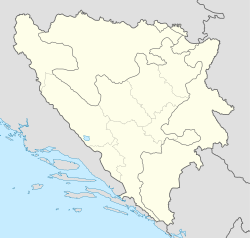Top Qs
Timeline
Chat
Perspective
Sanski Most
Town and municipality in Federation of Bosnia and Herzegovina, Bosnia and Herzegovina From Wikipedia, the free encyclopedia
Remove ads
Sanski Most (Serbian Cyrillic: Сански Мост, pronounced [sâːnskiː mɔ̂ːst]) is a town and municipality located in the Una-Sana Canton of the Federation of Bosnia and Herzegovina, an entity of Bosnia and Herzegovina. It is situated on the banks of the Sana River in northwestern Bosnia and Herzegovina, in the region of Bosanska Krajina, between Prijedor and Ključ. As of 2013, it has a population of 41,475 inhabitants.
Remove ads
Geography
Summarize
Perspective
It is located on the Sana River in Bosanska Krajina, between Prijedor and Ključ. Administratively it is part of the Una-Sana Canton of the Federation of Bosnia and Herzegovina. The Town sits on Nine Rivers, and they are : Sana, Dabar, Zdena, Bliha, Majdanska Rijeka, Japra, Sasinka and Kozica
Climate
Remove ads
History
Summarize
Perspective
In 1878, the little town (varošica) of Sanski Most was described as having a majority Bosnian Muslim population by the Croatian historian Vjekoslav Klaić.[2] From 1929 to 1941, Sanski Most was part of the Vrbas Banovina of the Kingdom of Yugoslavia.
During World War II, it was part of the Axis Independent State of Croatia (NDH), where the fascist Ustaše regime committed the Genocide of the Serbs and the Holocaust. At the beginning of May 1941 in several villages southeast of Sanski Most (Kijevo, Tramošnja, Kozica, etc.) the first armed conflict between the Ustaše and insurgent Serbs occurred. The event is known as the Đurđevdan uprising. In August 1941 on the Eastern Orthodox Elijah's holy day, who is the patron saint of Bosnia and Herzegovina, between 2,800 and 5,500 Serb civilians from Sanski Most and the surrounding area were killed by the Ustaše and thrown into pits which had been dug by the victims themselves.[3] The State Anti-fascist Council for the National Liberation of Bosnia and Herzegovina (ZAVNOBiH) held its second meeting from 30 June to 2 July 1944 in the town; it declared the equality of Muslims (Bosniaks), Serbs and Croats.
When the German and Italian Zones of Influence were revised on 24 June 1942, Sanski Most fell in Zone III, administered civilly by Croatia and militarily by Croatia and Germany.[4]
During the onset of the Bosnian War, the town was captured by the Army of Republika Srpska (Bosnian Serbs) and remained under its control until October 1995 when the Bosnian Army captured it during Operation Sana shortly before the end of the war. The Bosniaks and other non-Serbs were sent to large ethnic cleansing during its control by the Army of Republika Srpska (VRS). Following its capture by the Bosnian Army in October 1995, many Serbs from Sanski Most and Bosniaks from Prijedor exchanged homes due to their refugee status and the opposing federations.[5]
Vrhpolje Bridge Massacre
On 31 May 1992, the Army of Republika Srpska committed a massacre of 19 Muslim civilians on the Vrhpolje bridge in the Sanski Most municipality. 16 Muslim civilians were beaten on the bridge whilst the Bosnian Serb soldiers insulted them. The VRS had already murdered four on the way to the bridge. The Bosnian Serbs had ordered the Muslim civilians to remove most of their clothes, including their shoes, and then jump off the bridge. The Bosnian Serb soldiers played a game in which they would attempt to shoot the Muslim civilians mid-air whilst they were falling into the water. There was only one survivor of the massacre, Rajif Begić, who later testified against Ratko Mladić. According to the ICTY trial, Ratko Mladić was responsible for the murder of the Muslim civilians, which the court found was a deliberate attempt to ethnically cleanse the Serb-controlled parts of Bosnia and Herzegovina of their Muslim population in order to create a homogenously Serb ethno-state. According to Begić's testimony, the VRS had to kill 70 Muslims that day because "seven Serb soldiers had been killed in that area." Branko Basara, the retired commander of the 6th Krajina Brigade, was also indicted by the ICTY for war crimes that he committed in the Prijedor and Sanski Most area during 1992. Jadranko Palija, a Bosnian Serb soldier responsible for the massacre, was convicted of war crimes by the State Court of Bosnia and Herzegovina in 2007.[6][7]
In 1996, Serb-inhabited Oštra Luka was split from Sanski Most and ceded to the Republika Srpska entity.
On August 21, 2024 a man opened fire at the Sanski Most Gymnasium secondary school with an automatic rifle, killing three people.[8]
Remove ads
Demographics
Population
Ethnic composition
Remove ads
Economy
There are several non-governmental organisations in Sanski Most. The Center for Peacebuilding (in the local language "Centar za Izgradnju Mira (CIM)) has been active in the town since 2004. The "Fenix Center" provides humanitarian aid to people in need in the local community. The organisation "Krajiška Suza" provides care in medical, social, psychological, cultural and existential needs of people living in and around Sanski Most. Austrian manufacturer of exhaust pipes Remus has a manufacturing facility in Sanski Most that employs around 300 people.[10][11] Sanski Most was selected as one of the most successful local communities within the UNDP project that was financed by the Swiss embassy.[12]
Remove ads
Sports
The football club of the town is NK Podgrmeč.
Notable people
- Mehmed Alagić, general
- Milan Vukić, chess grandmaster
- Anna Ibrišagić, Swedish politician
- Enver Redžić, historian
- Kemal Malovčić, singer
- Milenko Zorić, Serbian sprint canoer, silver medalist at the 2016 Summer Olympics, World and European champion
- Vukašin Brajić, singer
- Milka Milinković, Paralympic track and field athlete, Croatia's most successful Paralympian
Gallery
- The Sana river
- Hamzibey's mosque
- An Orthodox church
See also
References
External links
Wikiwand - on
Seamless Wikipedia browsing. On steroids.
Remove ads











